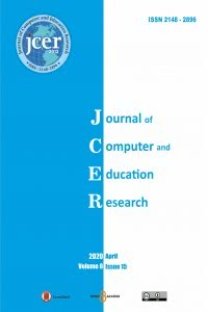Students' Experiences and Usability Evaluation in Interactive Digital Interface Development Process
Interface design, usability, user experience
Students' Experiences and Usability Evaluation in Interactive Digital Interface Development Process
Interface design, usability, user experience,
___
- Albert, B., & Tullis, T. (2013). Measuring the user experience: collecting, analyzing, and presenting usability metrics. Newnes.
- Butow, E. (2007). User interface design for mere mortals. Pearson Education.
- Çağıltay, K. (2011). İnsan bilgisayar etkileşimi ve kullanılabilirlik mühendisliği: Teoriden pratiğe (Human computer interaction and usability engineering: From theory to practice). Ankara: ODTÜ Yayıncılık.
- Dix, A., Finlay, J., Abowd, G. D., & Beale, R. (2004). Human-computer interaction. 3rd. Edition. Harlow: Pearson, Prentice Hall.
- Erdinç, O., & Lewis J. R. (2013). Psychometric evaluation of the T-CSUQ: The Turkish version of the computer system usability questionnaire. International Journal of Human-Computer Interaction, 29 (5), 319-326. https://doi.org/10.1080/10447318.2012.711702
- Galitz, W. O. (2007). The essential guide to user interface design: an introduction to GUI design principles and techniques. John Wiley & Sons.
- Georgiev, T., & Georgieva, E. (2009). User Interface design for mobile learning applications. e. Learning, 9, 145-150.
- Ghaoui, C. (2005). Encyclopedia of human computer interaction. IGI Global.
- Goldberg, J. H., & Wichansky, A. M. (2003). Eye tracking in usability evaluation: A practitioner's guide. In the Mind's Eye (pp. 493-516). North-Holland.
- Head, V. (2016). Designing interface animation: Improving the user experience through animation. Brooklyn, NY: Rosenfeld Media.
- Kraleva, R. S. (2017). Designing an interface for a mobile application based on children’s opinion. International Journal of Interactive Mobile Technologies (iJIM), 11(1), 53-70. https://doi.org/10.3991/ijim.v11i1.6099
- Lee, Y., & Kozar, K. A. (2012). Understanding of website usability: specifying and measuring constructs and their relationships. Decision Support Systems, 52(2), 450-463. https://doi.org/10.1016/j.dss.2011.10.004
- Lewis, J. R. (1995). IBM computer usability satisfaction questionnaires: Psychometric evaluation and instructions for use. International Journal of Human–Computer Interaction, 7 (1), 57–78. https://doi.org/10.1080/10447319509526110
- McKay, E. N. (2013). UI is communication: How to design intuitive, user centered interfaces by focusing on effective communication. Newnes.
- Nielsen, J. (1994). Usability engineering. Morgan Kaufmann.
- Norman, D. A. (2004). Emotional design: Why we love (or hate) everyday things. New York, USA: Basic Civitas Books.
- Park, K., & Lim, H. (1999). A structured methodology for comparative evaluation of user interface designs using usability criteria and measures. International Journal of Industrial Ergonomics, 23(5-6) 379-389. https://doi.org/10.1016/S0169-8141(97)00059-0
- Patton, M. Q. (2014). Qualitative research & evaluation methods: Integrating theory and practice. Sage publications.
- Rubin, J., & Chisnell, D. (2008). Handbook of usability testing: how to plan, design, and conduct effective tests. John Wiley & Sons.
- Salvendy, G. (2012). Handbook of human factors and ergonomics. New Jersey, John Wiley & Sons.
- Shackel, B. & Richardson, S. (1991). Human factors for informatics usability. Cambridge: Cambridge University Press.
- Yıldırım, A., & Şimşek, H. (2011). Sosyal bilimlerde nitel araştırma yöntemleri (Qualitative research methods in the social sciences). Ankara: Seçkin Yayıncılık.
- Yayın Aralığı: 2
- Başlangıç: 2013
- Yayıncı: Tamer KUTLUCA
Üniversite Öğrencilerinde Serbest Zaman Doyumu ile Üniversite Yaşamına Uyum İlişkisinin İncelenmesi
Zekâ Oyunlarının 6. Sınıf Öğrencilerinin Yaratıcı Düşünme Becerilerine Etkileri
Havva TERZİ, Betül KÜÇÜK-DEMİR
İngilizce Öğretmen Adaylarının Öğretmenlik Uygulama Sürecine İlişkin Düşünceleri
Suleyman KASAP, Mehmet Şirin DEMİR, Fırat ÜNSAL
Kısa Film Destekli Matematik Öğretiminin Değerler Eğitimi Yönünden İncelenmesi
Zühal GÜN ŞAHİN, Ramazan GÜRBÜZ
Sınıf Öğretmenlerinin Mesleki Becerilerinin Değerlendirilmesi: Diyarbakır İli Örneği
İlhami BULUT, Fatma TAŞDEMİR ÇELİKTEN
